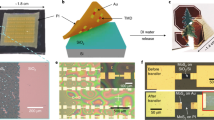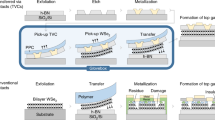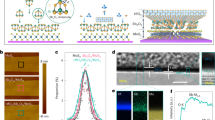Abstract
Two-dimensional (2D) materials such as transition metal chalcogenides can be used to create different components of electronic devices, including semiconducting channels and metallic electrodes and interconnects. However, devices are typically fabricated using a step-by-step process that can introduce defects and impurities, leading to a reduction in device performance. Here we show that 2D electronic components can be chemically synthesized and integrated simultaneously in a single step, creating 2D devices in which each component in the active layer is connected via covalent bonds instead of physical interfaces. The approach involves the phase-patterned growth of atomic layers, and, using 2D molybdenum ditelluride (MoTe2) as the active material, we show that it can be used to construct high-performance field-effect transistors (FETs) and arrays of logic devices. We also use the technique to construct FETs with ultrashort gate lengths, bilayered FETs with vertical interconnections and flexible devices.
This is a preview of subscription content, access via your institution
Access options
Access Nature and 54 other Nature Portfolio journals
Get Nature+, our best-value online-access subscription
$29.99 / 30 days
cancel any time
Subscribe to this journal
Receive 12 digital issues and online access to articles
$119.00 per year
only $9.92 per issue
Buy this article
- Purchase on Springer Link
- Instant access to full article PDF
Prices may be subject to local taxes which are calculated during checkout





Similar content being viewed by others
Data availability
The data that support the findings of this study are available from the corresponding authors upon reasonable request.
References
Moore, G. E. Cramming more components onto integrated circuits. Electronics 38, 114–117 (1965).
Packan, P. A. Pushing the limits. Science 285, 2079–2081 (1999).
Lundstrom, M. Moore’s law forever? Science 299, 210–211 (2003).
Lauhon, L. J., Gudiksen, M. S., Wang, D. & Lieber, C. M. Epitaxial core–shell and core–multishell nanowire heterostructures. Nature 420, 57–61 (2002).
Kong, J., Soh, H. T., Cassell, A. M., Quate, C. F. & Dai, H. Synthesis of individual single-walled carbon nanotubes on patterned silicon wafers. Nature 395, 878–881 (1998).
Wang, Q. H., Kalantar-Zadeh, K., Kis, A., Coleman, J. N. & Strano, M. S. Electronics and optoelectronics of two-dimensional transition metal dichalcogenides. Nat. Nanotechnol. 7, 699–712 (2012).
Ionescu, A. M. & Riel, H. Tunnel field-effect transistors as energy-efficient electronic switches. Nature 479, 329–337 (2011).
Desai, S. B. et al. MoS2 transistors with 1-nanometer gate lengths. Science 354, 99–102 (2016).
Qiu, C. et al. Scaling carbon nanotube complementary transistors to 5-nm gate lengths. Science 355, 271–276 (2017).
Shulaker, M. et al. Three-dimensional integration of nanotechnologies for computing and data storage on a single chip. Nature 547, 74–78 (2017).
Cho, S. et al. Phase patterning for ohmic homojunction contact in MoTe2. Science 349, 625–628 (2015).
Sung, J. H. et al. Coplanar semiconductor–metal circuitry defined on few-layer MoTe2 via polymorphic heteroepitaxy. Nat. Nanotechnol. 12, 1064–1070 (2017).
Huang, L., Zeng, Z. & Zhang, H. Metal dichalcogenide nanosheets: preparation, properties and applications. Chem. Soc. Rev. 42, 1934–1946 (2013).
Xu, M., Liang, T., Shi, M. & Chen, H. Graphene-like two-dimensional materials. Chem. Rev. 113, 3766–3798 (2013).
Voiry, D., Mohite, A. & Chhowalla, M. Phase engineering of transition metal dichalcogenides. Chem. Soc. Rev. 44, 2702–2712 (2015).
Zhou, L. et al. Large-area synthesis of high-quality uniform few-layer MoTe2. J. Am. Chem. Soc. 137, 11892–11895 (2015).
Zhou, L. et al. Synthesis of high-quality large-area homogenous 1T′ MoTe2 from chemical vapor deposition. Adv. Mater. 28, 9526–9531 (2016).
Wu, J. et al. High electron mobility and quantum oscillations in non-encapsulated ultrathin semiconducting Bi2O2Se. Nat. Nanotechnol. 12, 530–534 (2017).
Wu, Y. et al. Field-effect transistors made from solution-grown two-dimensional tellurene. Nat. Electron. 1, 228–236 (2018).
Hema, C. P. et al. High-mobility holes in dual-gated WSe2 field-effect transistors. ACS Nano 9, 10402–10410 (2015).
Bolshakov, P. et al. Improvement in top-gate MoS2 transistor performance due to high quality backside Al2O3 layer. Appl. Phys. Lett. 111, 032110 (2017).
Chu, P. et al. Locally gated SnS2/hBN thin film transistors with a broadband photoresponse. Sci. Rep. 8, 10585 (2018).
Liu, E. et al. Integrated digital inverters based on two-dimensional anisotropic ReS2 field-effect transistors. Nat. Commun. 9, 372–377 (2016).
Larentis, S. et al. Reconfigurable complementary monolayer MoTe2 field-effect transistors for integrated circuits. ACS Nano 11, 4832–4839 (2017).
Zhang, E. et al. Tunable ambipolar polarization-sensitive photodetectors based on high-anisotropy ReSe2 nanosheets. ACS Nano 10, 8067–8077 (2016).
Nathan, Y. et al. Waveguide-integrated black phosphorus photodetector with high responsivity and low dark current. Nat. Photon. 9, 247–252 (2015).
Young, C. et al. Evaluation of few-layer MoS2 transistors with a top gate and HfO2 dielectric. ECS Trans. 75, 153–162 (2016).
Mleczko, M. et al. HfSe2 and ZrSe2: two-dimensional semiconductors with native high-k oxides. Sci. Adv. 3, 1700481 (2017).
Nie, X. et al. Impact of metal contacts on the performance of multilayer HfS2 field-effect transistors. ACS Appl. Mater. Interfaces 9, 26996–27003 (2017).
Yu, L. et al. Enhancement-mode single-layer CVD MoS2 FET technology for digital electronics. Proc. IEDM 15, 835–838 (2015).
Lin, Y. M. et al. 100-GHz transistors from wafer-scale epitaxial graphene. Science 327, 662 (2010).
Lu, Z. et al. Universal transfer and stacking of chemical vapor deposition grown two-dimensional atomic layers with water-soluble polymer mediator. ACS Nano 10, 5237–5242 (2016).
Ciarrocchi, A., Avsar, A., Ovchinnikov, D. & Kis, A. Thickness-modulated metal-to-semiconductor transformation in a transition metal dichalcogenide. Nat. Commun. 9, 919 (2018).
Jiao, L. et al. Creation of nanostructures with poly(methyl methacrylate)-mediated nanotransfer printing. J. Am. Chem. Soc. 130, 12612–12613 (2008).
Acknowledgements
This work was supported by the National Science Foundation of China (grants nos. 21875127, 21573125, 51522212, 51421002, 51672307, 61574083 and 61434001), the Research Fund from Beijing Innovation Center for Future Chip, Beijing Municipal Science & Technology Commission (no. Z161100002116030), Tsinghua University Initiative Scientific Research Program, National Key R&D Program (grant no. 2016YFA0200400), the National Basic Research Program (grants nos. 2014CB921002 and 2015CB352101), the Independent Research Program of Tsinghua University (grant no. 2014Z01006), Shenzhen Science and Technology Program (grant no. JCYJ20150831192224146) and the Strategic Priority Research Program of the Chinese Academy of Science (grant no. XDB 07030200). The authors thank J. Zhang and S. Zhang for providing carbon nanotube array samples. The authors thank C. Li and H. Chen for performing tensile tests. The authors thank L. Zhou for the discussion on the growth of MoTe2.
Author information
Authors and Affiliations
Contributions
L.Y.J. and T.-L.R. co-supervised the study. L.Y.J. and Q.Z. conceived the ideas. Q.Z., X.-F.W., S.-H.S. and Q.L. performed the experiments. L.G., X.Y.Z., C.-P.Y. and X.Z.L. performed STEM measurements and analysis. H.Y.L. performed SEM and GIXRD measurements and analysis. J.Y.Z. performed EBL fabrications. L.Y.J., Q.Z., T.-L.R. and X.-F.W. co-wrote the manuscript. All authors discussed the results and commented on the manuscript.
Corresponding authors
Ethics declarations
Competing interests
The authors declare no competing interests.
Additional information
Publisher’s note: Springer Nature remains neutral with regard to jurisdictional claims in published maps and institutional affiliations.
Supplementary information
Supplementary Information
Supplementary Methods 1–5, Supplementary Notes 1–4, Supplementary Tables 1–2 and Supplementary Figs. 1–20.
Rights and permissions
About this article
Cite this article
Zhang, Q., Wang, XF., Shen, SH. et al. Simultaneous synthesis and integration of two-dimensional electronic components. Nat Electron 2, 164–170 (2019). https://doi.org/10.1038/s41928-019-0233-2
Received:
Accepted:
Published:
Issue Date:
DOI: https://doi.org/10.1038/s41928-019-0233-2
This article is cited by
-
Prediction of nonlayered oxide monolayers as flexible high-κ dielectrics with negative Poisson’s ratios
Nature Communications (2023)
-
Fabrication of p-type 2D single-crystalline transistor arrays with Fermi-level-tuned van der Waals semimetal electrodes
Nature Communications (2023)
-
Soft Electronics for Health Monitoring Assisted by Machine Learning
Nano-Micro Letters (2023)
-
Recent developments in CVD growth and applications of 2D transition metal dichalcogenides
Frontiers of Physics (2023)
-
Effect of chromium interlayer thickness on interfacial thermal conductance across copper/diamond interface
International Journal of Minerals, Metallurgy and Materials (2022)



